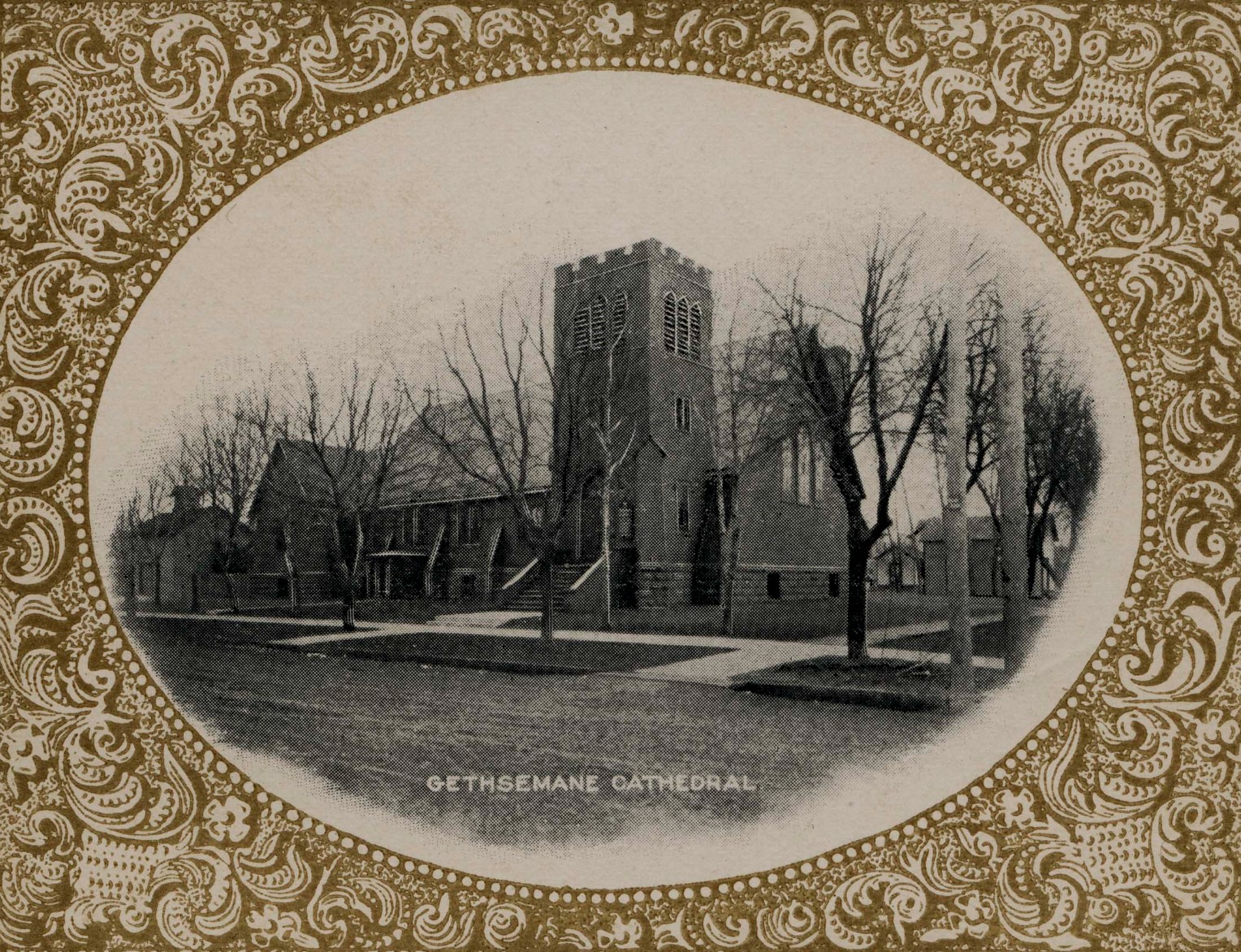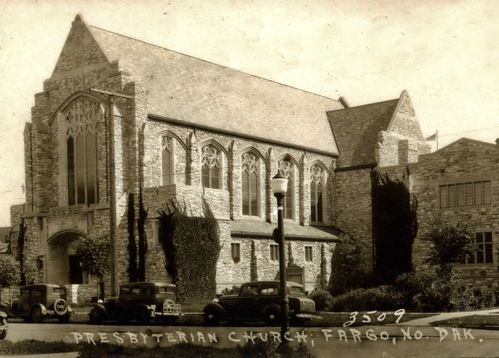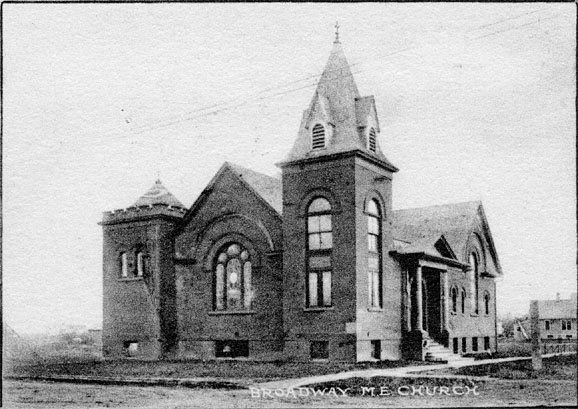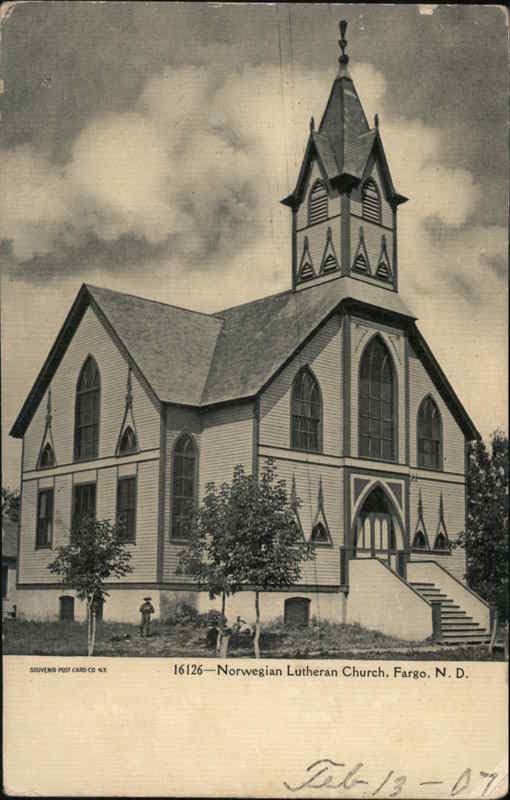In 1909, Fargo’s religious landscape was marked by a diverse array of churches, each contributing to the city’s spiritual and community life. Early congregations, such as Gethsemane Cathedral, established in 1873, and the First Presbyterian Church, organized in 1878, laid the foundation for religious practice in the city. By 1909, prominent churches included the Broadway Methodist Church, which had relocated and expanded to accommodate its growing congregation, and the First Methodist Episcopal Church, notable as the first church building in North Dakota. The First Baptist Church, Scandinavian Baptist Church, and Swedish Baptist Church served the needs of various ethnic communities, while the Norwegian and Swedish Lutheran churches provided spiritual homes for Fargo’s Scandinavian population. Additionally, the Jewish Synagogue, established in the late 1890s, reflected the city’s growing diversity. These churches, along with others like St. Mark’s English Evangelical Lutheran Church and Pontoppidan Norwegian Lutheran Church, played pivotal roles in the cultural and social fabric of early 20th-century Fargo.
Gethsemane Cathedral
While Fargo was still a city of tents, the first church service was held in the tent of the chief engineer by the Rev. J. A. Gilfillan, then rector at Brainerd.
In 1873 Bishop Clarkson of Nebraska, to whose jurisdiction this territory belonged, sent the Rev. Mr. Henry to Fargo. Though he remained but a short time he gave the mission its start. The railway loaned him a tent which was set up on the prairie near the present junction of N. P. Avenue and Broadway. When the company needed this tent, the use of “Pinkham’s Hall,” a small wooden building at the corner of Front and Third streets, was secured. Here, after the departure of Mr. Henry, lay-services were faithfully continued by Mr. B. F. Mackall, of Moorhead. This first mission was known as “The Church at the Crossing.”
In 1873 the Rev. H. C. H. Dudley became “Missionary on the line of the Northern Pacific Railroad,” having his home at Detroit, Minn. For two years his work covered five hundred miles of the railway with the charge of a number of towns, including Fargo. It was during this period — Mr. Mackall still acting as lay-reader — that the first church was built. Begun in the summer of 1874, on land given by General Cass, it was the scene of the first Episcopal visitation to the state, made by Bishop Clarkson in the fall of that year.
Mr. Dudley died of acute pneumonia on Ascension Day, 1875, and was succeeded by the Rev. Richard Wainwright, who made his headquarters at Fargo and first occupied the rectory, built that summer. He remained for two years. After his resignation in 1877 several clergymen rendered temporary service.
On Easter Day, 1881, the mission was organized into an independent parish, and in August the Rev. B. F. Cooley was called as rector. Under him the church was enlarged and beautified, the bell and the organ which are in present use being then secured, together with other furnishings.
In 1883 Bishop Walker, first bishop of North Dakota, chose Fargo as his see city, and when Mr. Cooley resigned in 1885, the bishop took temporary charge of the parish. In August of the following year, Rev. F. B. Nash became rector and remained until September 1895. To the energy, ability, and devotion of his service the parish owes much. These were fruitful years of rapid growth. In September 1895, Mr. Nash resigned and for nearly two years Bishop Walker was in charge of the parish, assisted during the latter portion of the time by the Rev. Irving McElroy.
In August 1897, Rev. Roderick J. Mooney became rector, and under him the present Catholic structure was built. The opening service was held January 11, 1900. Bishop Walker — who in 1898 had been transferred to western New York — joined with Bishop Edsall, his successor, in setting apart the structure to its sacred uses. As there is still a debt upon the Cathedral it has never been consecrated.
In May 1900, Mr. Mooney resigned the rectorship, Bishop Edsall taking temporary charge. In August of that year a change was made from a parochial to a Cathedral organization, and on September 1 Gethsemane Church became the Cathedral of North Dakota. The Rev. Hugh L. Burleson, the first dean, was installed on Sunday, November 3, 1900.
In 1901 Bishop Edsall was elected to the diocese of Minnesota, and was succeeded by Bishop Cameron Mann, who formally took his seat in his cathedral on the first Sunday in January 1902.
Many improvements have been made in connection with the cathedral property, the enlargement of the organ and the laying, on the entire property, of permanent cement walks. Better furniture for the sanctuary, and there is a small fund on hand toward the building of a parish house.
In February 1906, a disastrous fire threatened the destruction of the entire cathedral. The loss was covered by insurance, and the destroyed vessels and vestments have been replaced, so far as such things can be.
The great event of the year just past has been the assembling in Fargo at Gethsemane Cathedral, of the missionary council of the sixth department. This was a notable and successful gathering.
The Clergy
Right Reverend Cameron Mann, D.D., bishop.
Very Reverend Hugh L. Burleson, S.T.B., dean.
First Presbyterian Church
In 1878 the First Presbyterian Church was organized and in the same year, the first church building was erected, on the site of the present church. As the city continued to grow, their church proved too small for the large attendance, and in 1907 the new structure was completed and it was dedicated on April 7 of that year. Rev. C. B. Stevens, the first pastor, organized the church, the first Presbyterian church in Fargo. He died in March 1882. Rev. H. A. Newell remained about three years and was succeeded by Rev. D. E. Bierce, then Granville Pike, D. W. Day, and the present pastor, Rev. C. R. Adams.
Broadway Methodist Church
The Broadway Methodist Church was organized in October 1889, and three years afterward a lot was purchased on Roberts Street, on which a church was built, which was dedicated January 1, 1893, the same year of the Fargo fire. Work was immediately commenced on a new church which was finished and dedicated December 26, 1893. The congregation outgrew this church, and it was sold, and the property on Broadway was purchased in 1903, and the present edifice was erected in 1904. The following are the names of the pastors:
C. W. Cable, 1889-1890
D. C. Plannette, 1890-1893
J. A. Strachan, 1893-1895
C. A. Macnamara, 1895-1899
G. A. Henry, 1899-1901
Rev. Mr. Kline (supply), 1901-1902
M. V. B. Knox (supply), 1902
C. E. Vermilya, 1902-1905
A. A. Graves, 1905-1906
J. W. Danford, 1906-1907
J. S. DeLong, 1907-1909
First Methodist Episcopal Church
Rev. James Gurley was the first Methodist minister to preach in this territory; he itinerated between Duluth and Fargo in 1871 and 1872. He was followed by Rev. John Webb in 1873.
The First Methodist Episcopal Church of Fargo was the first church building to be erected in North Dakota. It was built in 1874 at a cost of $1,200.
The legal organization of the church was effected July 20, 1874. There were present Rev. J. H. Christ, Rev. John Webb, James Douglas of Moorhead, Minn., Alonzo Plummer, Mrs. Alonzo Plummer, Miss Emma Plummer, and William H. White.
A board of trustees was elected, consisting of William H. White, N. K. Hubbard, Alonzo Plummer, and G. I. Foster. William H. White was elected president of the board and has continued in that position to the present time. Mr. White was the only member of the Methodist Episcopal Church in Fargo, and as this was the first church to be organized in the state, he has the distinction of being the first man to have his church membership within the bounds of the state.
The first church building was replaced by a larger edifice, costing $5,000, which was opened for worship on Christmas, 1880.
In 1881 the Minnesota Conference held its annual meeting in Fargo, Bishop Cyrus D. Foss presiding.
The first session of the Dakota Mission Conference was held in Fargo in 1884, Bishop Charles Fowler presiding.
In 1887 the North Dakota Annual Conference held its first session in Fargo.
In the summer of 1894 fire partially destroyed this church building.
The present church building was dedicated August 21, 1898, by Bishop Isaac W. Joyce.
The Rev. J. B. Starkey was the first regular pastor stationed in Fargo. He began his work with five members, of whom Mrs. Elvira Cooper, Mrs. G. T. Foster, and Mr. William H. White are still members. The Sunday school was organized in 1873 with about twenty members, W. H. White being the superintendent. He was succeeded in 1881 by T. S. Quincey. Other superintendents have been Smith Stimmel, William Mitchell, W. P. McKinstry, S. B. Clary, Dr. C. N. Callander, and Robert McCulloch.
Following are the ministers, and dates of appointment: Rev. James Gurley, 1871, general missionary to the Northwest; Rev. John Webb, general missionary, 1873; Rev. J. B. Starkey, 1875, first regular pastor; Rev. M. Barnet, 1878, did not reach the field; Rev. H. B. Crandall, 1878; Rev. C. F. Bradley, 1879; C. N. Stowers, 1880; Rev. S. B. Warner, 1881; Rev. M. S. Kaufman, 1882; Rev. S. W. Ingham, 1888; Rev. G. S. White, 1888; D. W. Knight, 1889; Rev. Eugene May, 1891; Rev. W. H. Vance, 1896; Rev. H. G. Leonard, 1901, who is the present pastor.
First Baptist Church
The First Baptist Church was organized in 1879 with twenty-six members; services were held in Chapin Hall for a time, and McHench Hall, and while their first church was being built, services were held in the old school house, where the Unitarian church now stands. In 1881 they moved into their church and the organization was incorporated July 20 of the same year. There was no regular preacher at that period. Rev. George B. Vosbergh preached for them for three months; then he was succeeded by the first regular pastor, Rev. E. B. Haskell, who remained for three years. C. F. Hopkins came next, for a year. W. D. Holt was here during the summer of 1884. Rev. S. W. Stevens, three years; Rev. M. Barker, one year; Rev. J. W. Davies, one year; L. Van Horn, three and a half years; Rev. H. M. Cook, three years; Rev. W. L. Blanchard, two and a half years; Rev. W. W. Reed, three years; Rev. F. A. Hayward, through whose efforts the present church was erected, remained about three years. This church was dedicated May 14, 1905. Rev. Herbert Tilden is the present pastor.
First Norwegian Evangelical Lutheran Church
This organization had its birth in Moorhead, Minn., October 4, 1872, and the same year was incorporated. The following year, 1873, they erected a church in Moorhead, where services were held until about 1878; in that year a committee was appointed to look for land in Fargo for the building of a church; preaching was transferred to Fargo and they were without a church for some time. In 1893 a building was purchased, known as the Island Park Hall, and that was repaired and fixed up and where services were held for two years.
In 1895 the present edifice was built.
The following are the pastors from organization: Neils Th. Ylvisaker, the first pastor; J. Hellisdveidt, Rev. Mr. Ford, J. D. Bothne, J. O. Hougen, J. J. Heie, G. A. Larsen, and A. O. Fonkalsrud.
St. Paul’s Evangelical Lutheran Church
This church affiliated with the synod of the Norwegian-Evangelical-Lutheran Church in America, usually called the Norwegian Synod. After the First Norwegian-Lutheran Church, present pastor, Rev. Fonkalsrud, seceded from the Norwegian Synod in the early eighties (because of a doctrinal controversy). This denomination did not carry on regular church work in Fargo until 1903, when a congregation was organized by Rev. J. G. Rugland on August 3, 1903. In 1904 the Swedish-Lutheran Church building was bought and moved to its present location. Pastors: J. G. Rugland, E. A. Boyd, D. G. Jacobson.
The Scandinavian Baptist Church
The Scandinavian Baptist Church was organized in 1884 and the first church was built on First Avenue between Seventh and Eighth Streets South. It was incorporated February 25, 1888. The name of the church was changed February 24, 1900, to Norwegian Baptist Church, and in 1892 was moved to Fourth Street and Second Avenue North, where in 1900 the church was rebuilt and enlarged to what it now is. The ministers who have served the church during that time are as follows: J. A. H. Johnsen, T. O. Wold, L. I. Andersen, J. B. Sundt, C. W. Finwall, J. A. H. Johnsen, N. G. See, J. B. Sundt.
Swedish Baptist Church
This church was organized September 2, 1891, and the church edifice was erected in 1893. It was just completed when the great fire of that year destroyed it. Work was immediately commenced on another building, and in a short period was completed. On the 31st of March the church celebrated the burning of its mortgage, and is now free and clear of debt. The following have been its pastors: Rev. O. Lind, Rev. L. W. Linder, Rev. Mr. Johnson, Rev. Frank Liljegren, Rev. B. L. Carlton.
Swedish Lutheran Church
The church was organized in 1891 and incorporated in 1892. Rev. S. A. Lindholm was the first pastor. Services were held in the first church building until 1905, when they moved into their new building. The old church building was disposed of. The present church has a membership of 252. Ministers: Rev. S. A. Lindholm, Rev. E. Lund, Rev. J. A. Nyvall, Rev. J. Frangen, Rev. Mr. Palmer, Rev. N. O. Grunden.
St. Mark’s English Evangelical Lutheran Church
Lutheran services in the English language were held occasionally in Fargo during the summer and fall of 1885, but there being no resident pastor, no organization was effected. In the spring of 1886 Rev. W. F. Ulery, missionary of the general council, arrived and immediately entered upon the work of securing ground and materials for a church building. The cornerstone was laid on July 25, 1886, with appropriate services, the missionary in charge being assisted by the Revs. G. H. Trabert, D.D., A. J. D. Haupt, and W. K. Frick. The work of building was pushed forward as fast as possible, and on November 28, 1886, St. Mark’s English Lutheran Church was dedicated to the service of the Triune God.
The growth of the mission during the first year of its history was slow. The first regular communion service was held on Easter Sunday, 1887, at which service ten persons communed. On April 17 of the same year, a provisional organization was made, a constitution read and considered, and temporary officers elected. The organization was completed on May 18, 1887, at which time the constitution was adopted, and a church council elected.
In July 1887, Rev. Ulery resigned, and was succeeded by Rev. G. H. Gerberding, D.D., in August of the same year. During Dr. Gerberding’s pastorate, the mission continued growing in membership and in its financial operations, both for local expenses and for the various benevolent objects. The Sunday school soon outgrew its accommodations, and an addition 12×18 feet was built onto the rear of the church, used as a classroom for the primary department. Dr. Gerberding served the congregation until August 1894, and in October following was succeeded by Rev. H. K. Gebhart, followed by John A. Zundel. W. A. Ulrich is the present pastor.
Pontoppidan Norwegian Lutheran Church
This church was organized in 1878 by the Rev. Christian Wold, who was its first pastor and continued as such until 1884. The first church building was burned in 1893, and they immediately proceeded to erect a new church building. The next pastor was J. H. Brono. He served the church until 1903, excepting the year 1891 to 1892, when he was with a church in Minnesota. Rev. S. Romsdahl was the next pastor and is at the present time.
German Evangelical Association
There was no regular church of this denomination in Fargo in the early days, although as early as 1873 ministers were sent here from the Minnesota Conference, and from the Minneapolis district. It wasn’t until 1879 that there was any regular established church when the present structure was erected. Ministers: Rev. C. W. Stegner, Rev. E. F. Movius, Rev. J. Kienholz, Rev. C. Brill, Rev. W. Suckow, Rev. E. Oertli, Rev. S. F. Brown, Rev. E. Bectchel, Rev. J. Brookmuller, Rev. H. Lowen, Rev. L. N. Bingaman.
The Jewish Synagogue
The Fargo Hebrew Congregation was organized about 1894. They have held services for several years in Union Hall. The new and beautiful temple is now nearly completed, and the lower, or first floor, will be used as a day school, and for private meetings of the congregation. They have no settled pastor as yet.





